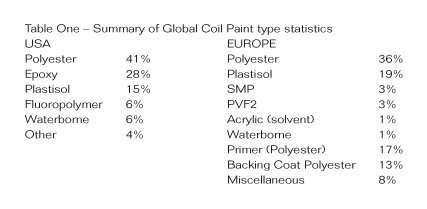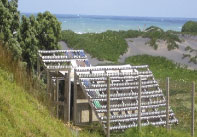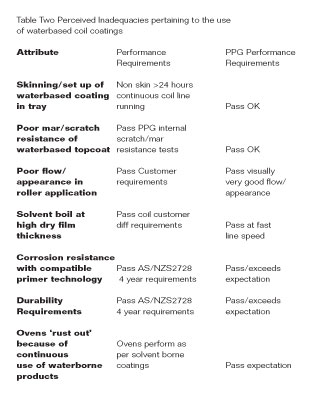Leading The World In Waterbased Coil Coatings
“At the last NZMRM Annual Conference, Dr. Lou Gommans from PPG Industries gave an interesting presentation on the coatings technology used to make the paints which coat many of New Zealand’s metal claddings. Significantly, and unexpectedly, he informed us that NZ leads the way in waterbased paint technology, with a far greater percentage of usage than anywhere else in the world. Our NZ-based knowledge, in which he is a world expert, is seen by the industry as world-leading.
With NZ’s “clean and green” image taking a few knocks from our indigenous greenies, it is good to hear that NZ industry does lead the world and that in our industry, the NZMRM, is leading the way.
We invited Lou to summarise this topic for Scope, and here it is. It is fairly technical but read it and you will find it worth while. As designers and makers of metal-clad buildings you can now take pride in knowing that they not only look great, they are contributing significantly
to NZ’s environment”
Stuart Hayman
Waterbased Coil Coatings Utilised ‘Down Under’
L.H.P.Gommans and A.R.Shekhumia PPG Industries New Zealand Ltd.
Waterbased coil coatings have been used in the New Zealand market since the late 1980’s. Some common misconceptions about the use of waterbased coatings for coil coating need to be dispelled. The performance requirements of waterbased topcoats, designed predominantly for the residential roofing and siding markets, can be benchmarked against the recently revised AS/NZS 2728 Standard.
Coil coating is a process whereby paint is applied to a coiled metallic substrate (usually by roller application) although other application techniques such as spray or hot melt have been utilised. The coil strip is chemically cleaned prior to stepwise application of chemical pre-treatment followed by a primer then a topcoat application. All coatings are thermally baked at peak metal temperatures of ca. 230°C prior to the recoiled coils being ‘consumed’ in the market.
Roofing and siding is the predominant market for coil coated product in Australasia.
The versatility of the coil coating process becomes clear when one considers that many substrates (CRS, HDG, Zincalume TM and Al) and many differing paint systems (polyester, vinyl, PVC, fluorocarbon etc) can be utilised to provide technical solutions for the variety of coil ‘end-users’.
The Coil Coating Process
An Environmental Perspective
Resin suppliers and paint manufacturers are constantly striving to supply products which will ultimately reduce the release of volatile organic compounds (VOC) into the atmosphere. The subject of air quality and the control of air pollutants from industrial processes is a very comprehensive and complicated area of research. Significant legislative efforts are underway to limit climate change via reduction of pollutant emissions to the environment.
The development of policies to protect human health and safeguard sensitive ecosystems is just as high on government agendas.
Coil coating processes traditionally use gas fired ovens with after burner incineration/thermal oxidizers to ensure that noxious emissions to the environment are controlled and minimized. Stringent legislative controls (i.e. Resource consent controls) are placed upon the released combustion products (other than carbon dioxide and water). All emissions must be free from droplets, persistent fume/mist and must be free from offensive odour (boundary condition).
These global requirements map closely with typical resource consent conditions for coil processing in NZ with the proviso that specific detailed resource consent condition requirements differ with local district authority practices.
Coil Coating can be considered as a ‘closed’ process – ‘closed’ meaning that all solvents and gas i.e. ‘fuels’ are consumed in the combustion process and all by-products efficiently incinerated/oxidized prior to discharge to the environment.
A survey of the predominant coatings technologies, currently utilized by the NCCA/ECCA Coil Communities (Europe/USA) is conspicuous by the absence of low VOC waterbased technology (Refer Table One).
In essence most of the technology summarised in Table One (excluding PVC Plastisol) is based upon medium solids, medium VOC solvent based technology. The exception is then PVC Plastisol which is a rapidly diminishing technology, because of expressed environmental concerns relating to the use of PVC and PVC Plasticiser technology. In addition Plastisol technology has a poor exposure performance record in Australasia’s severe UV/Thermal exposure environments.
Why then do medium solids’ solvent rich technologies continue to be used in the Coil Coating Process? The answer lies in the following bullet point summary.
- All paint technology products have 100% paint transfer (nil paint waste from overspray or potlife issues) - when roller coated.
- Economics/ease of use/durability/warranty considerations.
- The solvents in the paint are used as ‘fuel’ to cure the thermoset coating i.e. most ovens are gas fired.
- All combustion products (from gas fired ovens, polymer related split off volatiles) are ‘sanitised’ via afterburner incineration/thermal oxidizers/catalytic oxidisers.
- Waste containers are recycled i.e. 200ml drums, MBC or tanker supply
- The coil process is highly efficient w.r.t. energy consumption per m2/paint application.
- The coil process uses water sparingly (predominantly coil quenching processes prior to recoiling).

Other Considerations. Environmental and Sustainability Issues
The UK Government has published key themes for sustainable construction. These can be summarized as follows:
- Design for minimal waste.
- LEAN Construction and minimize waste (i.e. use light, strong materials).
- Minimize energy in construction and use.
- Do not pollute the environment.
- Preserve and enhance. biodiversity (i.e. ensure no impact on biological communities).
- Conserve water resources
- Respect people and the local environment.
- Monitor and report (i.e use benchmarks).
The environmental ‘friendliness’ of the coil coating process, coil recyclability, long span in service, easy maintenance, excellent aesthetics and appearance make coil coating a strong ‘environmental choice’. The alternative to coil coating processes are labour intensive spray applied processes, clearly these are not preferred cost effective options nor are they environmentally friendly ones.
The clear focus of sustainable development is to “improve the quality of life for all without increasing the use of natural resources beyond the capacity of the environment to supply them indefinitely “– this thinking is now mainstream. Considerable attention is being placed upon coating vehicles which can be seen as being carbon neutral through life cycle analysis studies. Research into sustainable acrylic technology is not surprisingly well advanced and well researched. Considerable effort is being focused upon generating sustainable acrylic raw materials via a number of novel processes (plant based production and /or generation from renewable feedstocks).
Acrylic technology is a very dominant global technology used for Surface Coatings- estimated to be 80% plus of the USA topcoat market.
Waterbased coatings with low VOC content are recognized as a preferred method of minimizing VOC emissions along with other options such as higher solids, powder, organic free coatings and radiation cure technology. The water based advantage becomes clearer when we look at “other Compliance matters” and refer to AS2728 requirements.
Other Compliance Matters
The awareness of sustainable materials and the issues listed below were considered as key drivers for change. In the 1980’s the NZ market moved away from solvent borne technologies (PVF2, SMP).
- Elimination of odour and toxicity associated with HAPS’s (Hazardous Air Pollutants) eg Isophorone in PVF2.
- Reduction of fire risks and associated ease of storage of large quantities of coil paint product in close proximity to hazardous, non flash-proof equipment (i.e. Ovens, electrical appliances).
- Nil capital investment to switch from solvent borne to waterbased technology.
- Removal of high vapour pressure HAP’s which possessed a risk to human health with bioaccumulation hazard in coater room environments (solvent borne products containing lower boiling point solvent cocktails with higher TWA/TLV thresholds cf. waterbased technology).
- Waterborne technology having proven durability advantages over solvent borne technologies.
- Regulatory compliance with Dangerous Goods Storage and HASNO product labelling requirements,
- disposal regulations for waterbased product much simpler than for solvent rich technology.
- Air resource consent requirements for fugitive emissions are minimized when water based options are exercised.
Summary of AS/NZS 2728:2007 – Prefinished/prepainted sheet metal products for interior/exterior building applications – Performance Requirements.
To quote from the Standard –
“The objective of this standard is to specify the requirements for prefinished sheet and strip intended for fabrication into products for use in the building industry.”
The “Standard classifies prefinished/prepainted metal products into six types according to their performance in respect to durability and aesthetics, in environments varying severity.”
The coil coated product types (there are six product types) are aligned with ISO 9223 Category and AS/NZS 2312/ISO9223 requirement descriptive. The corrosivity environment is correlated with corrosion rates of mild steel (μm/y) as a benchmark to measure corrosion rates.
The performance requirements for prefinished metal products cover standard aesthetic requirements as well as standard mechanical test property attributes i.e. appearance, specular gloss, dry film thickness, reverse impact, scratch resistance.
In addition and most importantly, the Standard covers key performance attributes for coil coated product types. These key performance product types being related to the –
- Durability of the organic film reflected in gloss loss, checking, chalking, colour change, cracking, flaking and peeling related to four year durability requirements of the organic coating at sunshine test sites. These sites have quantified solar weathering index requirements.
- Humidity resistance and corrosion resistance (Cyclic corrosion testing salt spray resistance, humidity testing and four year corrosion resistance tests at ISO9223 ranked corrosion resistance sites).
Performance of Waterborne Coatings in accordance with
AS/NZS2728 requirements
The waterborne topcoats supplied to the NZ market (from PPG) all meet with the four year durability requirements of the AS/NZS2728 Standard. PPG have adopted a continuous improvement philosophy to the development of new waterbased technology with developments of 5th and 6th generation topcoat technology already well into research and testing.
All new technologies are subject to AS/NZS2728 requirements prior to release into the market place.
Figure One illustrates PPG’s Muriwai exposure site (illustrating the severe corrosion resistance testing that these coatings need to endure prior to market release). This site is extremely aggressive, is classified as a C5 site (under ISO9223 nomenclature) being located 80 meters from the breaking surf. The AS/NZS 2728 Standard benchmarks all corrosivity requirements for this site such that all test data from this site can be correlated with other C5 sites on a global basis.
Figures Two and Three illustrates some long term exposure building case histories for high profile coil clad structures. The aesthetic appearance, longevity and enduring beauty of these coated finished buildings demonstrates that waterbased coating solutions can
perform and are performing well in the real world. In short the colour, gloss and chalking requirements are easily meet with AS/NZS 2728 requirements as well as Customer warranty expectations.
Table Two shows the perceived inadequacies of water based coil coatings – in reality none of these inadequacies stack up with the coil processes operative in NZ.
Coil Perspectives on Coatings for the Future
The performance of Coil Coating Systems for today and expectations for tomorrow is an important consideration.
In essence:
- n Performance expectations from the consumer (and the coil applicator) are increasing NOT decreasing.
- n Compliance expectations are becoming more stringent as one would expect as Environmental expectations continue to be driven hard through Regulatory Channels.
Waterbased coatings continue to develop and evolve at a great pace.
e.g. PPG already has 5th and 6th generation technologies already under development for topcoats, primers and backing coat technologies. The combination of good in-plant operational performance (long considered a draw back of waterbased coatings), excellent durability and good corrosion performance make waterbased Coil technologies of interest to all coil lines. The additional EH+S benefits realized in coater room environments, product storage, safety considerations, ease of transportation and lack of hazard ID protocol make waterbased Coil an interesting option. – no question about that......!
PPG Industries is a global leader in the diversified manufacturing and servicing of protective, decorative and automotive coatings, industrial and speciality chemicals, flat glass and fabricated glass products. Headquarters in the USA, and with 113 facilities in over 20 countries, PPG’s acquisition of US-based Ameron Coatings and European Sigma Kalon has strengthened its position in the heavy duty protective coatings market.
PPG Industries New Zealand Limited is New Zealand’s leading manufacturer and supplier of a broad range of industrial coatings with a proud and long-standing tradition of quality product and innovative technology. Utilising global resources, PPG Industries New Zealand Ltd. offers applications for wood, general industrial, coil-coating and protective & marine coatings markets, developed for South Pacific climates. This wide range of surface coating options also include powdercoating, can & package linings and pre-prime coatings for timber.
Telehone Toll Free: 0800 263 766.
www.ppgnz.co.nz
